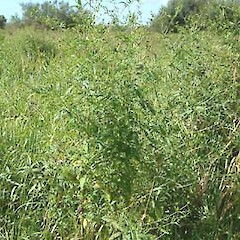Bidens frondosa
Common name
beggar’s ticks
Family
Asteraceae
Flora category
Vascular – Exotic
Structural class
Herbs - Dicotyledonous composites
NVS code
The National Vegetation Survey (NVS) Databank is a physical archive and electronic databank containing records of over 94,000 vegetation survey plots - including data from over 19,000 permanent plots. NVS maintains a standard set of species code abbreviations that correspond to standard scientific plant names from the Ngä Tipu o Aotearoa - New Zealand Plants database.
BIDFRO
Conservation status
Not applicable
Brief description
Tall upright annual, up to 2 m tall, with deeply divided leaves, yellow button-like flowers and characteristic flat black seeds with two barbed teeth easily attaching to clothing and hair.
Distribution
Locally abundant in northern and eastern North island, scattered elsewhere in the North Island and northern South Island as far south as Westland and Christchurch.
Habitat
Water body margins, swamps, damp waste places and low-lying areas.
Wetland plant indicator status rating
Information derived from the revised national wetland plant list prepared to assist councils in delineating and monitoring wetlands (Clarkson et al., 2021 Manaaki Whenua – Landcare Research Contract Report LC3975 for Hawke’s Bay Regional Council). The national plant list categorises plants by the extent to which they are found in wetlands and not ‘drylands’. The indicator status ratings are OBL (obligate wetland), FACW (facultative wetland), FAC (facultative), FACU (facultative upland), and UPL (obligate upland). If you have suggestions for the Wetland Indicator Status Rating, please contact: [Enable JavaScript to view protected content]
FACW: Facultative Wetland
Usually is a hydrophyte but occasionally found in uplands (non-wetlands).
Detailed description
Erect, glabrous or almost glabrous annual, 20-200 cm tall. Stems angled, branched above to form infl., and sometimes from base. Lvs petiolate, 1-pinnate, with 1-2 pairs of leaflets and a slightly larger terminal leaflet; leaflets sessile or shortly petiolulate, narrow-ovate to lanceolate, coarsely or unevenly serrate, acuminate, (1)-2-13 cm long. Upper cauline lvs becoming smaller, shortly petiolate, and often simple and not lobed or 3-lobed. Capitula 10-20 mm diam. Outer involucral bracts 4-9, foliaceous, usually ciliate at least at base, sometimes glabrous, linear to narrowly oblong-obovate, (10)-15-30 mm long; inner bracts many, membranous, triangular to subulate, 6-10 mm long, with dark lined centre and pale margins. Receptacular scales similar to inner bracts but narrower. Florets usually all ☿, tubular, yellow-orange, rarely a few orange ray florets present. Achenes flattened, ovate-cuneate with 1 slender rib on each face, dark brown, ciliate, and otherwise glabrous to sparsely hairy, 6-10 mm long; awns 2, 2.5-4.5 mm long.
Similar taxa
Non-flowering plants are superficially similar to cannabis. Differs from the two other Bidens species by the two toothed seed (3 or more in B. tripartita and B. pilosa) also having larger flower heads.
Flowering
November to April
Flower colours
Orange, Yellow
Fruiting
Autumn
Life cycle
Animal dispersed seed.
Year naturalised
1907
Origin
North America
Reason for introduction
Probably a seed or soil contaminant.
Control techniques
Can be controlled manually, mechanically or herbicidally depending on situation.
Etymology
bidens: From the Latin bi- ‘two’ and dens ‘teeth;, the seed having two tooth-like projections
Attribution
Prepared by Paul Champion and Deborah Hofstra (NIWA). Features description from Webb et al., (1998).
References and further reading
Webb, C.J.; Sykes, W.R.; Garnock-Jones, P.J. (1988). Flora of New Zealand Volume 4: Naturalised pteridophytes, gymnosperms, dicotyledons. Botany Division, DSIR, Christchurch.
Popay et al (2010). An illustrated guide to common weeds of New Zealand, third edition. NZ Plant Protection Society Inc, 416pp.
Johnson PN, Brooke PA (1989). Wetland plants in New Zealand. DSIR Field Guide, DSIR Publishing, Wellington. 319pp.











